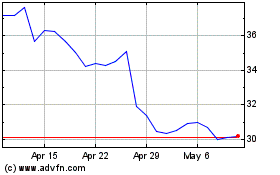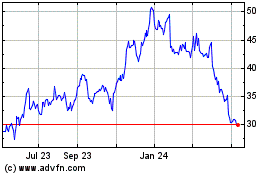Intel Hits a Novel Diversity Target It Calls 'Full Representation'
October 29 2018 - 9:29AM
Dow Jones News
By Yoree Koh
Intel Corp. on Monday announced an internal milestone in its
push for a more diverse workforce: It has achieved "full
representation."
But that doesn't mean it has reached gender or racial
equality.
Instead, the company says, its workforce now reflects the
available talent pool -- roughly 27% female, 9.2% Hispanic and a
little under 5% African American. Those numbers lag well behind the
overall population as well as the workforce at large, but Intel
says hitting this goal is a first step toward achieving broader
diversity.
Though no other companies are known to use "full representation"
as a metric, Intel is one of a growing number that are setting
concrete diversity goals -- but choosing benchmarks they think are
attainable in the near term.
AOL Inc. set a goal to have women in 50% of leadership positions
by 2020, while the German chemicals firm BASF SE said it wanted
women in 22% to 24% of leadership positions -- up from 19% -- by
2021 to match the percentage in its global workforce.
Twitter Inc. said earlier this year it would set diversity goals
every two years instead of on an annual basis. It also said it
would narrow its goals to focus exclusively on increasing
representation of women and African American and Hispanic workers.
In the past, it had set goals for the percentage of women and
underrepresented minorities generally in technical and nontechnical
roles.
Other large companies have committed to achieving equal pay for
men and women. Still, while nearly all companies say they want to
build diverse workforces, most decline to disclose their goals
publicly.
Some companies are hesitant to join Paradigm for Parity, a
coalition of over 80 companies that have pledged to reach gender
parity in executive ranks by 2030. "They don't want to sign
something that they are fearful that they can't achieve," said
Jewelle Bickford, co-chair of Paradigm for Parity.
Ms. Bickford, a partner at Evercore Wealth Management, said she
and her co-chairs spend considerable time talking to prospective
participants about "what you can do to get started and so on and
assuring them that nobody is going to blame them if they're not
quite there."
Intel coined the phrase in 2015 when then Chief Executive Brian
Krzanich announced the push for "full representation" by 2020 and
earmarked $300 million to spend towards strategic initiatives to
get there.
The company said it bases "full representation" on market
availability, which it calculates by pulling from different
sources, including university graduation data from the National
Center for Education Statistics, the U.S. Census Bureau and
internal company data.
The target is "not particularly aspirational," said Joelle
Emerson, founder and CEO of Paradigm, a diversity-and-inclusion
strategy firm based in San Francisco. It "means we are as
representative as basically other organizations in our
industry."
Ms. Emerson said she commends Intel for setting a goal at
all.
In many ways, Intel's numbers are similar to those disclosed by
other tech companies struggling to diversify their ranks beyond
white and Asian men, particularly in leadership and technical
positions. The skilled labor force remains shallow in those areas.
For example, at Intel, African Americans make up just 1.8% of their
technical executives and just over 2% of technical managers.
Hitting the internal target is "like one inch on the 12-inch
ruler," said Barbara Whye, Intel's chief diversity and inclusion
officer, who says the company's next likely goal is to be more
reflective of the U.S. population.
Ms. Whye said Intel has baked diversity and inclusion goals into
the business, with 7% of all employee bonuses tied to hiring and
retention goals. About 45% of hiring must be considered "diverse
hiring," and the exit rate of "diverse" employees 0.5% less than
majority counterparts.
Women and under-represented groups like Hispanic and
African-American workers are now leaving at a slower rate. Ms. Whye
attributes the improvement to initiatives like the company's
WarmLine, which catches workers who may be thinking about leaving
because they do not feel challenged or included.
The efforts have run into headwinds. For instance, Ms. Whye said
Intel changed the hiring process to make sure diverse candidates
are considered for new jobs and people of different backgrounds are
on interview panels. But she discovered that "diverse" employees
were still being overlooked for promotions because they tended to
go through the formal application process, whereas other employees
made use of informal networks to land new jobs within the company.
Now, all employees must apply for jobs through official
channels.
Intel's diversity work may also have been challenged by its
corporate woes. The Wall Street Journal has reported that the U.S.
Equal Employment Opportunity Commission is investigating the
company for allegedly targeting older workers in its massive
layoffs in recent years.
Mr. Krzanich, who captained the 2015 diversity initiative,
resigned in June for violating company policy by having a
relationship with a co-worker. Ms. Whye said the circumstances
around Mr. Krzanich's departure didn't affect recruiting.
--Kelsey Gee contributed to this article.
Write to Yoree Koh at yoree.koh@wsj.com
(END) Dow Jones Newswires
October 29, 2018 09:14 ET (13:14 GMT)
Copyright (c) 2018 Dow Jones & Company, Inc.
Intel (NASDAQ:INTC)
Historical Stock Chart
From Mar 2024 to Apr 2024

Intel (NASDAQ:INTC)
Historical Stock Chart
From Apr 2023 to Apr 2024
